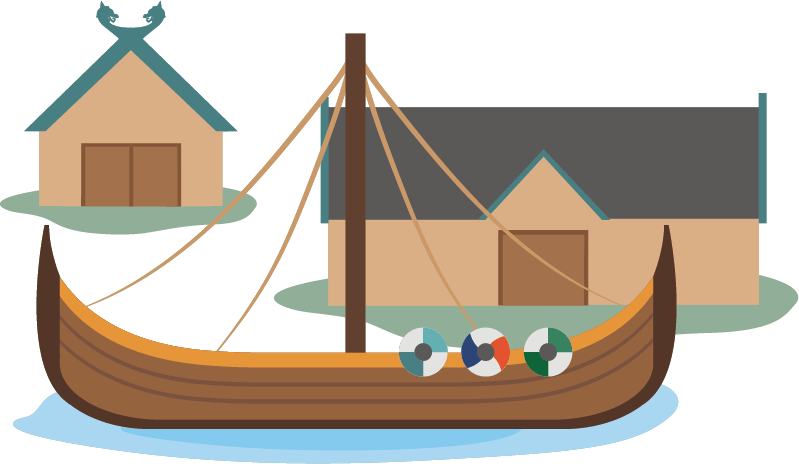Bake delicious bread rolls at home!
Weather permitting, it's a great weekend activity to light a fire and gather the family - and maybe friends - around the campfire for a bit of fun and bread baking.
Here's our recipe for shortbread, so you can always mix a good dough quickly and easily:
You will need (for approx. 8 loaves):
25 g yeast
2.5 dl water
1 tsp. salt
1/2 tsp. sugar
400 g wheat flour
Here's how you do it:
Crumble the yeast and stir it into lukewarm water. Add salt, sugar and flour and knead the dough well until smooth. Let the dough rise covered for about 30 minutes.
Then you're ready to bake the bread!

Add edible herbs and plants to the breadcrumbs!
Do you want to make your snow bread extra delicious, just like when you were on an expedition with us? Then go on your own expedition around the garden or out into nature and collect edible plants to flavor your bread.
Here's a list of the most common plants that grow in West Jutland at this time of year, so you know what to look for:
Autumn

Apples
Edible part: Everything
Apples are one of the world's most popular and recognizable fruits. And with good reason, as they can be used for almost anything - from dried and pickled to baked or fresh from the tree.

Meadowsweet
Edible part: Flowers and leaves
Previously used for brewing mead, hence the name. The flowers and leaves have a spicy and aromatic flavor, and the flowers can be used for juicing in the same way as elderflower juice.

Hazel
Edible part: Nut butters
Nuts have been used for thousands of years. Excavations from the Stone Age have found large quantities of nutshells. The animals that eat hazelnuts help to spread them, such as squirrels, mice and birds.

Sea buckthorn
Edible part: The berries
Sea buckthorn often grows close to the sea in calcareous soil. The tart, yellow berry has become incredibly popular and can be used in everything from jams to juices.

Lingonberries
Edible part: The berries
Lingonberries have been used for thousands of years in the Nordic countries. When the Egtved Girl was found near Vejle, archaeologists discovered the remains of a bucket containing the sediment of beer brewed from lingonberries.

Quince
Edible part: The innards
This plant was already popular in the Middle Ages, where it was a symbol of fertility. In the 18th century, it was said that those who ate quinces had wise children.

Rosehips
Edible part:
It gets its name from ancient times. The roots of the shrub were used to treat rabies. The fruits are high in vitamin C and have been used in folk medicine for many different diseases.
Summer

Chives
Edible part: Leaves, flowers and roots.
Chives are a classic in Danish cuisine. It was one of the most popular herbs back in the 1950s and still is today. It is also known as egg onion, as it is often used in egg cakes.

Wild marjoram
Edible part: Leaves and flowers.
Wild marjoram has been used to dye clothes, as a cough medicine and as a spice. It is mentioned in a letter from Queen Dorothea in 1551. According to superstition, it should be planted two days before the full moon.

Sage
Edible part: Leaves.
The plant grows wild in southern Europe and came here with the monks in the Middle Ages. It was cultivated in monastery gardens as a medicinal plant and was used to cure colds and toothaches, among other things.

Violin
Edible part: Flowers.
Violet is also known as pansy. In the Middle Ages, the plant was thought to be particularly noble, probably because of its fragrance and beauty. It has been used as a medicine for bladder stones and has been seen as a harbinger of spring.

Thyme
Edible part: Leaves and flowers.
There are many different species and great variation in both taste and scent. The name comes from the Greek "thymiane", which means incense. As a medicinal plant, it is used to strengthen our immune system, digestion and it is also good for those who have problems with asthma.

Snakewort
Edible part: Leaves.
Snakewort has been used as an ornamental plant in gardens. It is most commonly found in western and northern Jutland.

Dandelion
Edible part: Leaves, flowers and roots.
The dandelion roots can be made into a coffee substitute drink, however, it does not contain caffeine. The flowers have been used in food and for schnapps. The new leaves are good in salads.
Closer to nature!
Throughout the history of West Jutland, gathering herbs and food in nature has been a deeply ingrained practice that connects people to their environment and fosters a deep respect for the natural world. Today, many have moved further away from nature, but with simple steps like using more fresh, wild and seasonal plants in your cooking, you can get a little closer to nature again.










